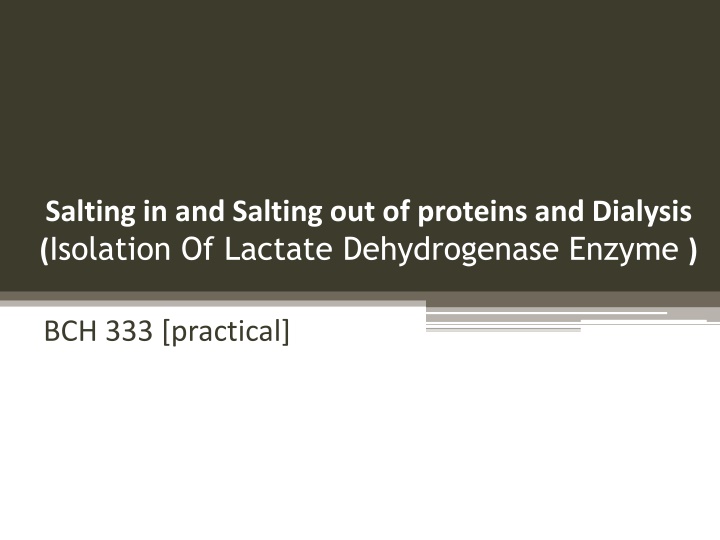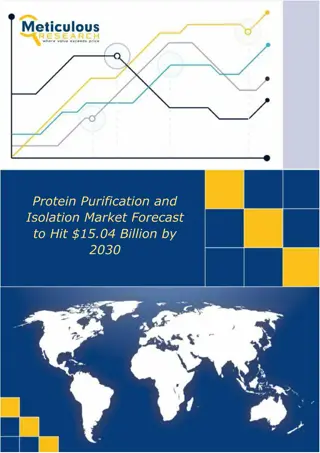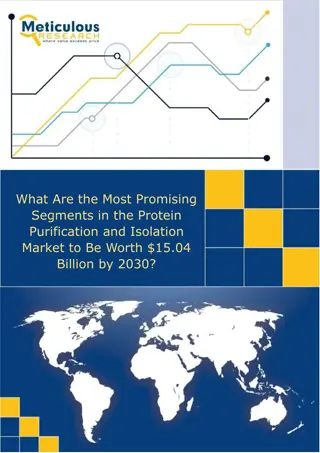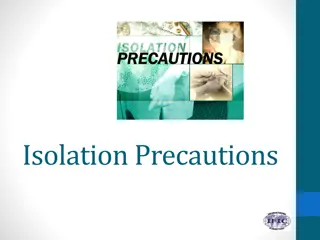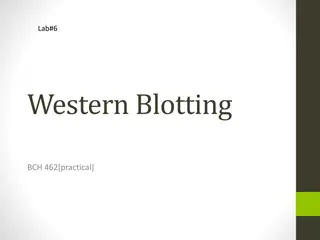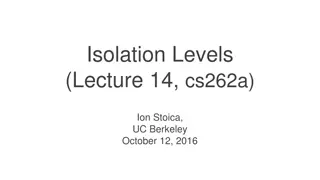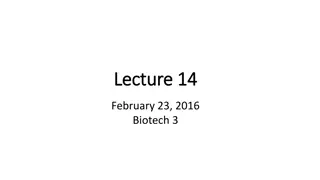Protein Isolation Techniques: Salting In and Salting Out
Proteins exhibit varying solubility based on salt concentrations, with salting in increasing solubility and salting out causing precipitation. This practical involves isolating lactate dehydrogenase enzyme using salting in, salting out, and dialysis techniques, as well as assessing purity through activity assay and protein content via Bradford assay.
Download Presentation

Please find below an Image/Link to download the presentation.
The content on the website is provided AS IS for your information and personal use only. It may not be sold, licensed, or shared on other websites without obtaining consent from the author.If you encounter any issues during the download, it is possible that the publisher has removed the file from their server.
You are allowed to download the files provided on this website for personal or commercial use, subject to the condition that they are used lawfully. All files are the property of their respective owners.
The content on the website is provided AS IS for your information and personal use only. It may not be sold, licensed, or shared on other websites without obtaining consent from the author.
E N D
Presentation Transcript
Salting in and Salting out of proteins and Dialysis (Isolation Of Lactate Dehydrogenase Enzyme ) BCH 333 [practical]
Objective: 1-To learn the technique of isolation of proteins on the basis of their solubility. salting in, salting out of proteins 2-dialysis of proteins. 3-Determinatioin of protein content by Bradford assay. 4-assess the purity of the enzyme through an activity assay.
-Proteins show a variation in solubility depending on their solution ionic environments. 1- salting in: When the solubility of proteins increased in low concentration of salts it called salting in. -e. g the effects of salts such as sodium chloride [NaCl] on increasing the solubility of proteins is often referred to as salting in. - When low concentrations of salt is added to a protein solution, the solubility increases. This could be explained by the following: Salt molecules stabilize protein molecules by decreasing the electrostatic energy between the protein molecules which increase the solubility of proteins.
Salting out: -when the proteins precipitate at high concentration of salts it called Salting out. -When the ionic strength of a protein solution is increased by adding salt, the solubility decreases, and protein precipitates. This could be explained by the following: The salt molecules compete with the protein molecules in binding with water.
Many globular proteins precipitate out at very low ionic strengths or in pure water. This happens because different proteins are able to interact favorably leading to formation of a complex. When this complex formation is extended between many protein molecules, it can lead to protein precipitation. Some salts, such as high concentrations of ammonium sulfate, have general effects on solvent structure that lead to decreased protein solubility and salting out. In this case, the protein molecules tend to associate with each other because protein-protein interactions become energetically more favorable than protein- solvent interaction. -Proteins have characteristic salting out points, and these are used in protein separations in crude extracts.
The most effective region of salting out is at the isoelectric point of the protein because all proteins exhibit minimum solubility in solutions of constant ionic strength at their isoelectric points. The salt commonly used is ammonium sulfate because: 1. Its large solubility in water. 2. Its relative freedom from temperature effects. 3. It has no harmful effects on most of the proteins. Note: the amount of salt needed to isolate a specific protein is determined from the salt's fractionation table.
Dialysis Removal of salt molecules from the isolated protein solution through a semi permeable dialysis bag is called dialysis. The salt molecules move from the more concentrated solution (from inside the dialysis bag) to the less concentrated solution ( e.g. distilled water).
-Increase solute solvent interaction increase the solubility. -Increase solute solute interaction decrease the solubility. -Increase ionic strength increased salt concentration.
Isolation Of Lactate Dehydrogenase Enzyme 1. Homogenization: -Is a generic term which refers to processing a solution so that it becomes uniform. It is used to break down the tissue and rupture the cell membrane to release its content. -Cell Homogenate: is the result of homogenization process. - The homogenization buffer: Tissue is typically homogenized in an isotonic buffer solution, This is done to stop osmotic damage. The samples are then kept cold to prevent enzymatic damage .
2-Sedimentation by applying centrifugal force : -The crude homogenate obtained from step one is centrifuged to separate the cell debris from the cellular extract . -The cell debris have a higher density thus will sediment while the components of the cellular extract (including the target enzyme ) have a smaller density and thus will remain suspended in the solution . Thus this step will result in a pellet that contains the cell debris and any remaining unbroken cells , and a supernatant representing the cellular extract that contains the target enzyme LDH .
3.Isolation and protein separation by Salting Out : In Salting out an extremely polar compound (ammonium sulfate in this case ) is added to a protein solution , the ammonium sulfate attracts the water molecules thus competing with the protein molecules for the hydration water molecules , as salt concentration increases proteins become attracted to each other , clump and precipitate out of solution . Different proteins precipitate at different salt concentrations due to differences in their structures .
a) A 40% cut ( a salt concentration of 40% is applied), which precipitates a bulk of unwanted proteins .The salting out step is followed by centrifugation which separates the unwanted precipitated proteins from the solution (pellet contains unwanted proteins and supernatant contains LDH and other proteins ). b) A 65% cut ( a salt concentration of 40% is applied) , which will precipitate the target enzyme LDH out of the solution .The salting out step is followed by centrifugation which separates the precipitated LDH from the solution (pellet contains LDH and other proteins and supernatant contains unwanted proteins ).
4-Samples collected from each step should be examined for protein concentration and enzyme activity: a) The protein concentration will be determine using Bradford assay: which should be decreasing as purification proceeds . [the concentration of each fraction should be decrease each time we discarded the unwanted proteins]. b) Enzyme activity: - The purity of wanted fractions [fraction contain LDH] is assessed by analyzing each fraction for this enzyme activity. So, it can be used to evaluate the success of fractionation process. -Enzyme activity of LDH should be in its maximum activity in its specific fraction.
5-Specific Activity: -Specific Activity is relates the enzyme activity to the amount of protein in the sample. -We can measure the amount of protein, and we can measure the enzyme activity. Combining the two will give us the specific activity. -Specific activity is defined in terms of enzyme activity per mg protein in the sample (ie, specific activity relates the enzyme units to the amount of protein in the sample). -By determine the enzyme activity of the marker enzyme [LDH] and protein concentration, we can determine the specific activity of [LDH] in each fraction. enzyme activity protein concentration Specific activity=
LDH kit: -Method principle: LDH catalyze the following reaction: L-Lactate + NAD Pyruvate + NADH + H+ -The rate of NADH formation is indicted by increase in absorbance at 340 nm and is directly proportional to serum LDH-L activity -Reagent bottle contain L-Lactate and NAD, the enzyme [LDH] present in the fraction will cause the formation of Pyruvate + NADH + H+.
